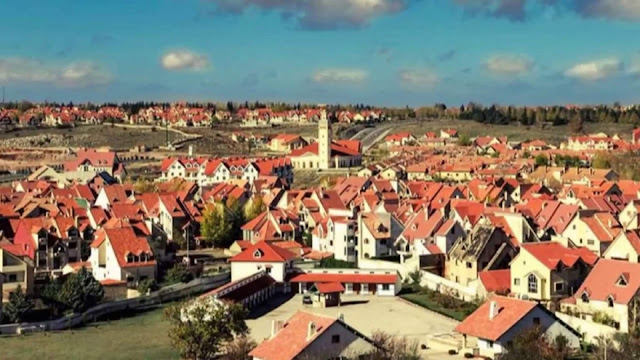TUBKAL MOUNTAIN IN MARRAKECH
Toubkal or Tubkal in Arabic: توبقال, is a mountain peak in southwestern Morocco, located in the Toubkal National Park. At 4,167 metres or 13,671 feet, it is the highest peak in the Atlas Mountains, Morocco, North Africa and the Arab World. Located 63 km or 39 miles south of the city of Marrakech and it can even be seen from it, although much of the High Atlas consists of sedimentary rocks, the Toubkal massif is a part of volcanic rocks which have weathered into alpine crests cut by deep narrow valleys. To the south, the mountain drops steeply down for 1,800 metres to a tiny low lake called Lac d'Ifni. To the west, the mountain's edge is marked by a pass, the Tizi n'Ouanoums at 3,664 metres. From this pass, the mountain's W-S-W ridge rises up to Toubkal West, which forms a shoulder at 4,020 metres before continuing to the summit at 4,167 metres.
The north and western side of Toubkal drains all the way down to the Mizane Valley, which has the passes of both Tizi n'Ouanoums and Tizi n'Ouagane at its head. Two hanging valleys on the western side of the mountain, the Ikhibi Nord and Ikhibi South provide ready access for trekkers and climbers to succeed in Toubkal's summit. At just one occasion the northern valley provided the conventional route of ascent but the development of a mountain hut by the French Alpine Club below Ikhibi Sud now encourages trekkers to ascent via the southern route instead. Ikhibi Sud the traditional route. From the Toubkal refuge, a path crosses the stream, climbs a steep scree slope to the east and enters a dangling valley, then climbs another steep slope to achieve a col of Tizi'n'Toubkal at 3,940 metres. At the col the route turns left northwards up easy slopes to the narrow summit crest of Jebel Toubkal. Ikhibi Nord Not as frequently ascended as Ikhibi Sud but technically easier. The route starts far down the valley from the Toubkal refuge and turns right eastwards to follow a track up through a dangling valley to a col on the side of Toubkal. Ascent: 1,000 metres in 3–4 hours. The col also gives access to adjacent peaks of Imouzzer 4,010 metres and Tibherine 3,887 metres. West-North-West "W.N.W" Ridge "ONO Arete". First ascent by J de Lepinay and party in 1936. Infrequently climbed but an extended and pleasant traverse containing many gaps and towers. Some difficulties may be avoided by means of an abseil. Grade III/IV and it can take about 7 hours.



The ascent during the summer which start from May is non-technical yet moderately difficult, only complicated by steep and slippery scree slopes and hypoxie. Sturdy boots and proper windproof clothing are required and trekking poles are helpful on the scree. An ice-axe could also be needed on the remaining snowfields within the early summer. The ascent during the top of the winter and spring which start from February and March is harder, crampons are necessary to ascend through the snow and ice in some cases. Toubkal is popular trekkers and ski mountaineers but less so with climbers, despite its easy access and sunny climate. Trekkers usually approach the mountain from Marrakech via the road end village of Imlil. Qualified guides may be hired, in addition as porters, to hold equipment and food supplies higher into the mountains.

The normal route starts with a simple walk to the village of Armed. Past Armed a floodplain is crossed and therefore the route follows the left slope of the valley southwards. The valley bends to the east to the small settlement of Sidi Chamharouch, which has grown around a Muslim shrine, the trail leads over the stream and runs steeply uphill to the correct side of the Isougouane valley, which results in two stone-built refuges old Neltner Refuge and new Refuge du Toubkal that are often used as base camp at 3,207 metres. it's possible to shop for good meals within the Refuge du Toubkal. Tents may be pitched near the refuges for a tiny low charge.
The first recorded ascent was on 12 June 1923 by the Marquis de Segonzac, Vincent Berger and Hubert Dolbeau but the mountain may possibly are climbed before that date. Toubkal's height was measured the subsequent year and determined as being 4,165 metres. Nowadays measured at 4,167 metres, the summit is crowned with an oversize pyramidal metal trigonometric marker and offers views taking in most of the Atlas and small chain of mountains. it's possible to climb mountain Toubkal in two days, first day up to the refuge around 7 hours, second day to the summit around 5 hours and back to Imlil up to 5 hours.
Climbing Mount Toubkal is a wonderful introduction to your mountaineering adventures, taking only an extended weekend to complete. Jebel Toubkal offers a really different experience to climbing the eu Alps. Enjoy Moroccan cuisine, beautiful mountain landscapes and warmer climates as you ascend this iconic mountain. In summer the mountains will be very dry but are sometimes subject to storms. Although the temperature should remain above zero during the day, freezing conditions are possible over 3,500 metres. In winter the mountains are covered in snow and ice and may be at risk of avalanches. Skiing is feasible because the snow can delude considerable depth and canopy many rocky slopes.









Commentaires
Enregistrer un commentaire